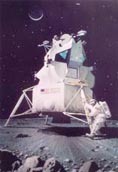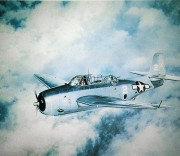|
AirVenture Adventure *
by Carlton W. Austin
So you want to fly to Oshkosh? We have some tips from the pros.
There’s a secret burning passion in the heart of every pilot. It’s fueled by the same stuff that propelled Howard Hughes, Sir Richard Branson and, most recently, Steve Fossett.
No, that stuff isn’t piles of money. It’s a yearning for adventure. And while most of us won’t get the chance to set any world records, there is one goal we—almost to a pilot—share. We’d like to fly ourselves to that aviation Xanadu known as Oshkosh. Just the thought is enough to make you both drool and break out in a cold sweat. After all, that’s why they call it AirVenture.
So you’ve decided this is the year. What next? Well, we’ve talked to some veterans, and they offered several tips and strategies to help get you there. (We’ll assume you’ll fly VFR, because that’s what most people do, and IFR flyers end up doing the same visual approach as the VFR guys anyway.)
Everyone we spoke to agreed on one thing: Flying to Oshkosh is nothing more than a cross-country flight—except for the final few miles. The approach to landing is what puts the adventure in Airventure. It is by necessity visual. It’s different. It’s very exciting. And it is what puts off most pilots going in the first place. Who wants to risk life and limb mixing in with a swarm of aircraft all intent on landing in the same place at approximately the same time? But more about this momentarily.
A second crucial factor concerns your route of flight. And while there obviously are various routes available, one question looms large: to cross Lake Michigan or not? Because if you flight-plan direct to OSH from just about any Mid-Atlantic departure point, the great circle route you get will send you smack across a 50- to 90-mile stretch of open water. So these two overarching considerations are where the focus of your planning should be.
As the old Chinese proverb says, a journey of a 1000 miles begins with the first step, and that step, according to Ron Dixon of Bowie, Maryland, who stables a Musketeer, a MiniCoupe and a Teenie Two at Suburban Airport in Laurel and who has made the trip no less than a dozen times since 1974, is to sit down with the AirVenture NOTAM and other information available from EAA’s Web site (see sidebar). Read it all carefully. Read it again. Then fly the last 50 miles in your head—repeatedly.
Dixon is not an advocate of crossing Lake Michigan. He points out that almost annually some hapless pilot has to ditch; many are never recovered. But if you must cross do it within gliding distance of shore. He prefers taking a more leisurely route north of Columbus, Ohio, past Ft. Wayne and Gary, Indiana, skirting south of the Chicago area and avoiding the Lake completely. Though it’s no problem making the trip in one day, Dixon likes to overnight, preferably at some small town near a grass strip, where he can get a “last refreshing shower” and an early launch.
In fact everyone interviewed said to plan on an early arrival; otherwise you may find the airport closed because it’s filled to capacity. Or if you arrive later than about 2 p.m., the airport will be closed for its air show schedule. Best bet? Arrive the day before the official show opening, which this year is scheduled for Monday, July 25.
Air show pilot Mark McKibben, whose Pitts Special routine wows the crowds at the Flying Circus in Bealeton, Virginia, from May through October, has a different view. He last made the Oshkosh trip in a Beech Debonair in one day, stopping only at Toledo Express, which he says “positions you for the shortest crossing of the lake north of Chicago.” And while he takes some comfort in large number of freighters in the shipping lanes, he recommends packing a life preserver. “Be talking to someone all the time,” he said. “Use flight following, and if you must ditch, do it next to a ship.”
No matter which route you take, you—and almost everyone else—will end up converging over a small Wisconsin town by the name of Ripon (pronounced “rippin”). “Start listening on the radio from 50 miles,” Dixon advises. “Get a feel for what to expect.” This means getting the OSH ATIS information well prior to beginning the approach at Ripon. (Warning: this overview is not a substitute for the official “Special Flight Procedures AirVenture Oshkosh 2005 NOTAM,” due out in May.)
It’s called the Fisk VFR arrival procedure at Ripon, and this is where the fun really starts. This is what you’ve dreamed about—or perhaps dreaded. But it’s easy. First and always, look for traffic. Then just follow the railroad tracks northeast out of Ripon, heading for Fisk, a small town and visual checkpoint where a temporary ATC trailer is looking for you. When a controller sees you, he will call only your make and color, e.g., “Orange Musketeer over Fisk.” In reply you’ll just rock your wings, “vigorously” as the OSH controllers say. You won’t use your radio (unless specifically directed to do so).
Now is the time for hyper vigilance, for at this stage you’ll be cheek-to-jowl with a lot of other airplanes. McKibben suggests you take someone with you—a valuable second set of eyes. On one trip Dixon recalls being “sandwiched between a Cherokee and a Bearcat,” a WWII Navy fighter plane. It’s nothing unusual during these final frenetic moments before touchdown at Oshkosh.
Once on the ground, follow one ironclad rule: DO NOT BACK-TAXI ON RUNWAY! Depending on the runway used, there will be a set procedure. Again, refer to the NOTAM; trust it completely.
Dixon has a final word of encouragement: “Don’t let Oshkosh’s reputation intimidate you. Just follow the NOTAM. Once on the ground, it’s a great feeling of accomplishment.”
“AirVenture Adventure”: Sidebar
Your one-stop resource for everything AirVenture on the Web is www.airventure.org. You can also get there from www.eaa.org. I can tell you from personal experience that AirVenture is the best organized, best managed and best implemented large-scale gathering of people since the construction of the pyramids. EAA’s AirVenture Web site is no different. It is excellent and comprehensive.
Some additional advice. Dixon says, “You can always camp with your plane, so don’t hesitate to fly out at the last minute.”
McKibben advocates a portable chair because “seating is limited.”
Everyone recommends taking a comfortable pair of shoes, lots of socks and plenty of sunscreen.
Oh, and Mom says not to forget your toothbrush!
* (This article first appeared in AutoPilot Magazine, and is reprinted with permission.)
Back to Top
|



